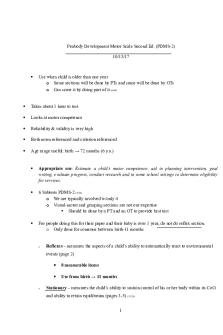A2-Nature and Nurture - KNES370: DR. TIM KIEMEL MOTOR DEVELOPMENT PDF

| Title | A2-Nature and Nurture - KNES370: DR. TIM KIEMEL MOTOR DEVELOPMENT |
|---|---|
| Course | Motor Development |
| Institution | University of Maryland |
| Pages | 2 |
| File Size | 86.4 KB |
| File Type | |
| Total Downloads | 94 |
| Total Views | 155 |
Summary
KNES370: DR. TIM KIEMEL MOTOR DEVELOPMENT...
Description
Sardonna Siu KNES370 Section 0104 A2: Nature and Nurture
We tend to think about nature and nurture in a competitive sense, saying “nature versus nurture” looking at which has a greater impact, but both play a crucial role in developing an individual and work together to do so. Nature refers to the genes that are transmitted from parent to child at conception, which plays a major role in characteristics such as height and eye color. It would be arrogant to ignore the idea that abilities are passed down from generation to generation, especially because we see members of the same family in the same athletic fields, but it must be simultaneously paired with the environmental factors that they are able to develop these skills. In studies done on twins in the late 1900s, research showed that genetics play a notable role in the heritability of athletic traits such as muscle mass, strengths and oxygen uptake. (Yan et al., 2016)1 The importance of environmental factors, or how you nurture an individual during a sensitive period, is equally as important as genetically inherited characteristics; the influence of family and friends, society and culture are included in this category. Age and birth date are environmental factors that influence ones success. One in an ability group born in January will tend to excel in an ability more than another in the same group born in September because they the advantage of extra months of physical maturity. Players born in January will be selected to play in higher leagues with access to better coaches and training, further widening the gap between those getting better access and those who are tossed to the side because they don’t play on the same level as those almost a year older than them. (Gladwell, M., 2008)2 This shows that ones environment highly influences how one is able to develop; those with better access to training will continue to grow while those who don’t have to wait for
Sardonna Siu KNES370 Section 0104 another opportunity to be “chosen.” Explaining a family line of basketball players can and is typically explained by heredity, but we can also place an environmental influence here because one may feel a pressure to continue a family “tradition” or think its what will make their family happy. In addition to this, if you have a genetically transmitted ability, your family and friends may push you to pursue it, making you practice harder in order to live up to the talent they perceive you possess. It is easy to compare both hereditary and environmental factors that may influence one’s motor development, but we have a lot more work to do in identifying connections between the two. We must stop asking each other which is more influential and start observing how they work conjunctionally to aid an individual’s motor development.
References: •
Posthumus M, Collins M (2016): Genetics and Sports, ed 2, revised, extended. Med Sport Sci. Basel, Karger, 2016, vol 61, pp 15–28 (DOI: 10.1159/000445238)
•
Gladwell, M. (2008). Chapter One: The Matthew Effect. In Outliers: The Story of Success.
•
Kiemel (2021). “M03A: Nature & Nurture I” Motor Development. Feb. 15, 2020. University of Maryland.
•
Kiemel (2021). “M03B: Nature & Nurture II” Motor Development. Feb. 15, 2020. University of Maryland....
Similar Free PDFs

Gross-Motor Development Essay
- 7 Pages

Chapter 5 Motor Development
- 22 Pages

Atu: Motor development
- 8 Pages

Nature Versus Nurture
- 2 Pages

Nature and Nurture - Grade: A+
- 5 Pages
Popular Institutions
- Tinajero National High School - Annex
- Politeknik Caltex Riau
- Yokohama City University
- SGT University
- University of Al-Qadisiyah
- Divine Word College of Vigan
- Techniek College Rotterdam
- Universidade de Santiago
- Universiti Teknologi MARA Cawangan Johor Kampus Pasir Gudang
- Poltekkes Kemenkes Yogyakarta
- Baguio City National High School
- Colegio san marcos
- preparatoria uno
- Centro de Bachillerato Tecnológico Industrial y de Servicios No. 107
- Dalian Maritime University
- Quang Trung Secondary School
- Colegio Tecnológico en Informática
- Corporación Regional de Educación Superior
- Grupo CEDVA
- Dar Al Uloom University
- Centro de Estudios Preuniversitarios de la Universidad Nacional de Ingeniería
- 上智大学
- Aakash International School, Nuna Majara
- San Felipe Neri Catholic School
- Kang Chiao International School - New Taipei City
- Misamis Occidental National High School
- Institución Educativa Escuela Normal Juan Ladrilleros
- Kolehiyo ng Pantukan
- Batanes State College
- Instituto Continental
- Sekolah Menengah Kejuruan Kesehatan Kaltara (Tarakan)
- Colegio de La Inmaculada Concepcion - Cebu










